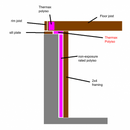Polyiso for Fire Blocking
Can exposure rated polyiso insulation (like Thermax) be used for fire blocking?
Working to finalize plans on my finished basement with open joist ceiling.
Walls will be non-exposure rated polyiso glued to the concrete foundation walls, cut even with the top of the walls, with 2×4 framing butt up against the insulation.
Rim joists will be exposure rated polyiso, either Dow Thermax or Johns Manville CI Max (whichever I can source cheaper I suppose).
The gap between the top of the foundation wall and joists (1.5″ on walls perpendicular to to the joists, larger on parallel walls) is still in question, as I’m trying to determine the fire blocking setup for this area.
Best solution would be 1.5″ expose rated polyiso, but this would only work if it’s approved as a fire blocking material. Like the attached picture, highlighted in red. If I need to use alternate fire blocking, I could use 1/2″ drywall, but that would reduce my insulation thickness to 1″, which is insufficient in my opinion. I really want to insulate the top of the foundation wall back to the sill plate. Or I suppose I could shove mineral wool up in the joist bays expending out to the edge of the 2×4 framing. This would mean the insulation would be exposed for view from within the living space, which is suboptimal, but I could get away with non-exposure rated polyiso in all locations, which is a good amount less expensive and could make up for the cost addition from the mineral wool.
Thanks
GBA Detail Library
A collection of one thousand construction details organized by climate and house part










Replies
I'm not exactly sure what you're trying to do here, but I think you're confusing terms a bit. Neither Dow Thermax nor Johns Manville CI Max is rated for use as a "fire blocking" (usually called "fire stop") material. What they ARE rated for is to be left exposed WITHOUT a THERMAL BARRIER. Thermal barriers and ignition barriers are not the same thing as fire stops. Think of this as the thermal barrier making this a more fire resistant assembly, similar to how drywall will SLOW DOWN, but not PREVENT the spread of fire.
Normally you don't have to fire stop the area shown in your drawing, because the subfloor will extend over the top of the rimjoist and will prevent fire from going up into the wall cavities (remember -- all of this "prevent fire from..." stuff really means SLOWS DOWN the fire from doing stuff, it is not fire PROOF).
You're probably OK with even regular foil faced polyiso here, as I haven't seen any local building people take issue with small amounts of insulation of this type used in the rim joist area, which actually has some exceptions for things like spray foam in terms of fire codes. If you want some extra protection, or if your local building department is requiring it, you might want to consider using an intumescent coating. Mineral wool is another option as you mentioned, and you could extend your drywall up into the space between joists to conceal it, although that would add a lot of cutting and you'd probably want some edge trim.
Bill
I refinished my basement last year. The building/code inspectors should lay all of this out for you. Mine wanted to see only drywall or plywood between the top of the wall framing and the ceiling joist and butt against the sill plate/rim joist. In addition, I used Rockwool as both an insulation/blocking/sound proofing at the end of the ceiling joist/rim joist. It is very dense and worked great. I put it in the joist bays too, which dampens the noise between floors considerably.